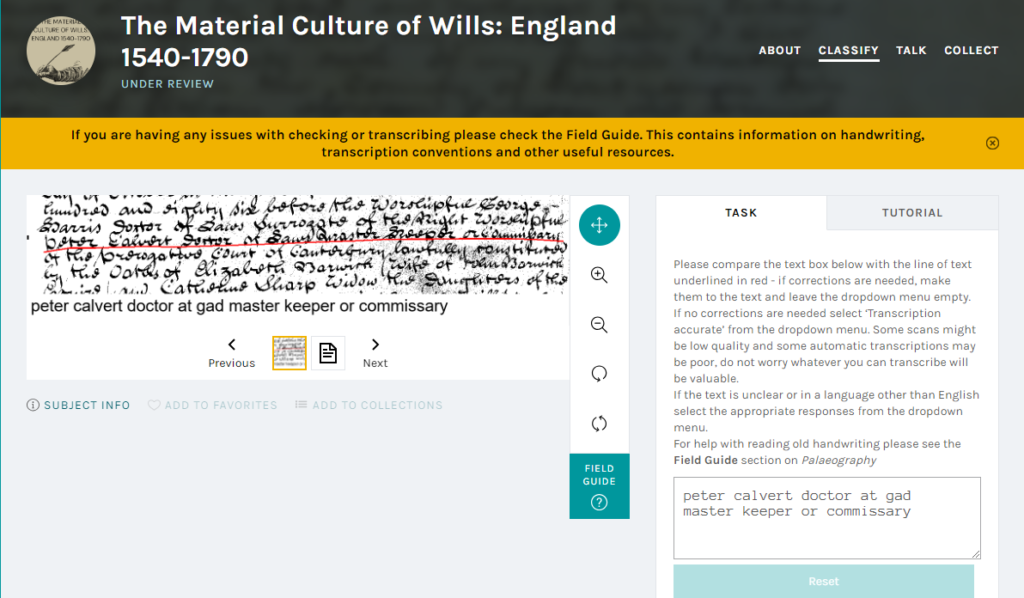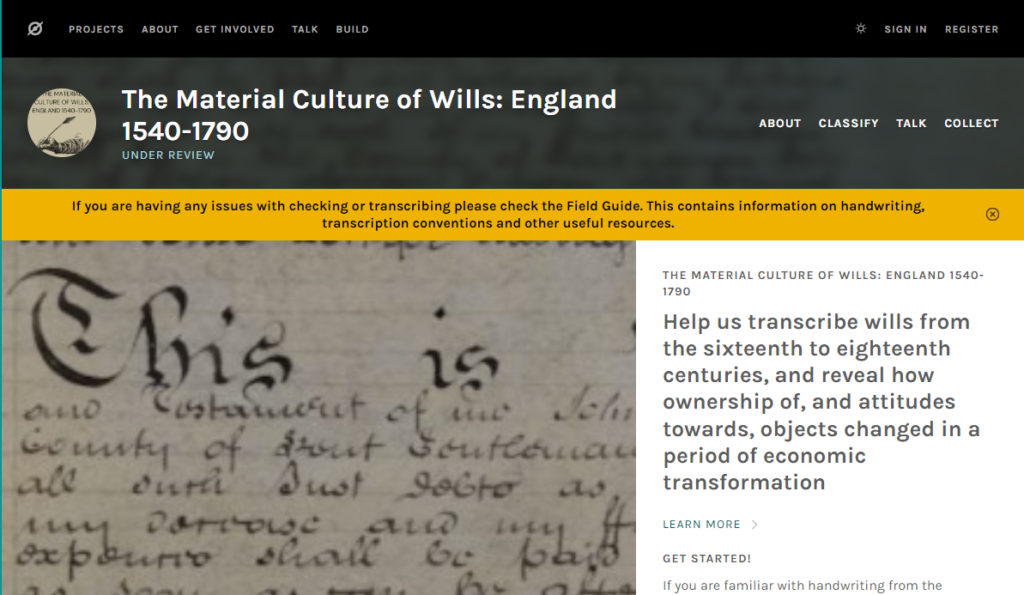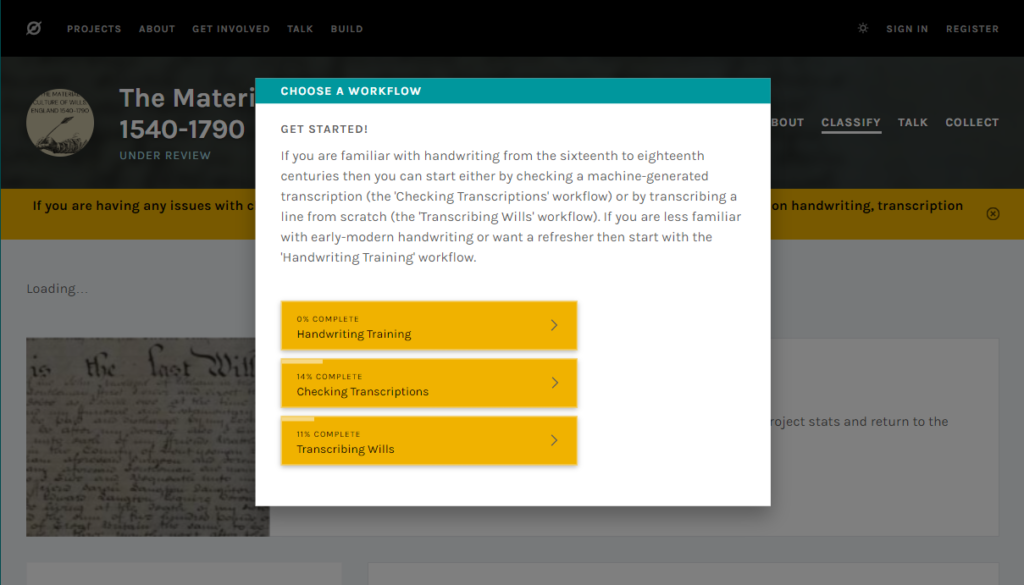Posted by e.m.vine@exeter.ac.uk
16 October 2024We’re delighted to announce an exciting new phase of the ‘Material Culture of Wills’ project – the launch of our Zooniverse site. We hope that the Zooniverse ‘crowdsourcing’ platform will allow us to involve hundreds of new volunteers in the project who will work with us to transcribe our sample of 25,000 English wills made between 1540 and 1790. This post explains the bite size tasks participants will be asked to complete, and what the benefits are of joining the volunteer community.

How does the Zooniverse volunteer community fit into the project as a whole?
In our project to date we’ve worked intensively with a small group of expert volunteers to develop cutting-edge Artificial Intelligence by training a Handwritten Text Recognition (HTR) model. We’ve now used this HTR model to automatically transcribe the contents of wills from five periods: 1538-52, 1604-08, 1664-6, 1725-6 and 1785-6, totalling 25,000 wills in total. The transcriptions produced by the HTR model aren’t 100% accurate however, and sometimes it gives inconsistent results for the different styles of handwriting that appear in these Tudor, Stuart, and Georgian documents. Harnessing the skills and knowledge of volunteers will enable us to improve the accuracy and overall quality of our transcriptions.

What exactly does contributing on Zooniverse involve?
Participants can help us check these automatically generated transcriptions and suggest corrections where needed. Using the online ‘Zooniverse’ platform, you will be shown one line of text from the manuscript wills at a time, and will be asked to compare each image with its automatically generated transcription. You don’t need to sign up or create a Zooniverse account, and you are welcome to contribute as much or as little as you would like – the ‘bite-size’ transcription checking tasks are designed to fit around other commitments. Checking a line of text can be done on your computer, tablet, or smartphone – you could have a go while waiting for the kettle to boil, or while standing at the bus stop. We estimate that we have around 2 million lines of text to check in total, and each line will be checked 3-4 times – this is why the project team can’t do this without your help!

Why get involved?
By joining us on Zooniverse, you’ll become part of a research project which aims to reveal how ownership of, and attitudes towards, objects changed in a period of profound economic transformation. The data you create will become the basis of various academic presentations and publications. By helping us transcribe these wills, you’ll make a vital archive of English history more accessible, and lay foundations for future initiatives to widen access to The National Archives’ manuscripts. You’ll have the opportunity to improve your reading of Tudor, Stuart, and Georgian handwriting as training is provided on our Zooniverse site. By contributing to the project you can also join a vibrant Zooniverse community and talk to other interested volunteers on our dedicated project talkboards. Finally, we hope that you’ll find reading these snapshots of early modern English life just as interesting as we do, since wills can provide a window into the lives of people who lived hundreds of years ago that we otherwise don’t have much information about.

Where do I start?
To have a go at working with early modern wills and to help us to open up this manuscript collection to as wide an audience as possible, visit our Zooniverse site at: https://www.zooniverse.org/projects/hjsmith/the-material-culture-of-wills-england-1540-1790
When you first visit the site, click on ‘Classify’. A dialogue box will prompt you to pick a workflow – ‘Handwriting Training’, ‘Checking Transcriptions’, or ‘Transcribing Wills’.
If you want a refresher for reading early modern handwriting, you might want to start with ‘Handwriting Training’, or otherwise click ‘Checking Transcriptions’. When you click on any of these three workflows, a pop-up ‘Tutorial’ will appear. Work through the ‘Tutorial’ to begin with, and you can also revisit it at any point.

Where do I find further guidance?
If you’ve already worked through the ‘Tutorial’, have a look at the ‘Field Guide’ – it’s a blue link in between the will image and the transcription box when you’re completing a workflow. The ‘Field Guide’ contains guidance for reading the handwriting (palaeography), sample alphabets and common words and phrases, and our transcription conventions. You can also have a look at our FAQ page, or if there’s anything else you’re not sure about, you can see if your question has been answered, or talk to other users or members of the project team on our project talkboards.
If you prefer a visual guide, we’ve also created some ‘quick start’ guides to using Zooniverse on our YouTube channel: https://www.youtube.com/@MaterialWills
Remember, each line will of text will be shown to 3-4 users – so don’t panic if you’re not sure what it says – we have lots of mechanisms in place to check that the final transcriptions are accurate.
We very much hope to see you over at Zooniverse, and please, do tell your friends!